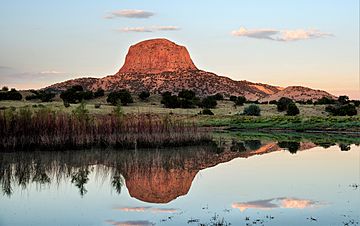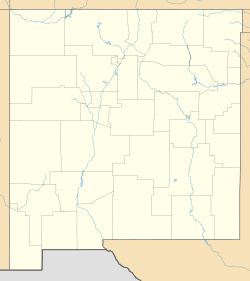Cabezon Peak facts for kids
Quick facts for kids Cabezon Peak |
|
|---|---|

Cabezon Peak at sunrise
|
|
| Highest point | |
| Elevation | 7,785 ft (2,373 m) |
| Prominence | 1,508 ft (460 m) |
| Isolation | 10.35 mi (16.66 km) |
| Parent peak | Pt 9114 |
| Geography | |
| Location | Sandoval County, New Mexico, US |
| Parent range | Colorado Plateau |
| Topo map | USGS Cabezon Peak |
| Type of rock | basalt |
| Climbing | |
| Easiest route | class 3+ scrambling |
Cabezon Peak is a huge, interesting volcanic plug found in northwestern New Mexico. It stands tall at 7,785 feet (2,373 meters) above sea level. This means it rises almost 2,000 feet from the flat ground of the Rio Puerco Valley below.
Cabezon Peak is about two miles south of the old ghost town of Cabezon. It is also near the Rio Puerco river. This amazing rock formation is made of a dark rock called basalt. It is part of the larger Mount Taylor volcanic area.
Contents
What is Cabezon Peak?
How Volcanic Plugs Form
A volcanic plug, also called a volcanic neck, is like the leftover "throat" of an old volcano. Imagine a volcano erupting. Inside, hot, melted rock called magma pushes up through a pipe or neck. When the volcano stops erupting, this magma cools down and becomes solid rock inside the pipe.
Over millions of years, the softer rock and dirt around the volcanic pipe wear away due to wind and rain. This process is called erosion. What's left standing is the hard, solid plug of rock that was once inside the volcano. That's exactly what Cabezon Peak is!
Rocks Around the Peak
Around the bottom of Cabezon Peak, you can see older rocks from the Cretaceous period. This was a very long time ago, when dinosaurs roamed the Earth. These rocks include the Mancos Shale and the Point Lookout Sandstone. These types of rocks often form in ancient seas.
The Name and Its Story
Meaning of Cabezon
The name "Cabezon" comes from the Spanish language. It means "big head." This name fits the peak well because it looks like a giant head rising from the ground.
The name also comes from a special story told by the Navajo. In their myths, there was a giant named Ye’i-tsoh. He was a very powerful and scary giant. Two brave twin heroes, Nayenezgani and To’badzistsini, fought and defeated him. The Navajo myth says that Cabezon Peak is the giant Ye’i-tsoh's head, left behind after the twins defeated him.
Gallery







